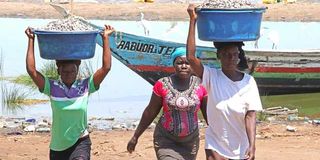13 Fish breeding sites set for gazettement to help increase Lake Victoria's fish stock

The offshore breeding sites have many juvenile and mature fish, mainly the Nile Perch.
What you need to know:
- The offshore breeding sites have many juvenile and mature fish, mainly the Nile Perch.
- According to Dr Aura, breeding periods were mainly occurring in the rainy season, that is March to May and October to December.
Fishermen in the Western Region are set to benefit from an initiative to boost fish breeding by demarcation of the sites. This is bound to increase the wild catch of fish that is currently decreasing at Lake Victoria.
The initiative is being done by Kenya Marine and Fisheries Research Institute to demarcate fish breeding sites, sheltered bays and river mouths that could help increase wild catch at Lake Victoria.
National Lake Victoria Beach Management Unit (BMU) chairman Tom Guda welcomed the project saying that it will have a long-term effect on aquatic life in the lake. Tom Mboya, a fisherman in Dunga noted many fish varieties such as lungfish, catfish and haplochromines had started to disappear.
“This is because of trespassing into the breeding site juvenile fishing, making these fish varieties go extinct. For fish to thrive and breed, they need an area that is free from noise and commotion, and therefore these areas need to be protected,” said Mr Mboya.
"Apart from demarcation, it is important to protect these breeding sites. Once the gazettement has been done, the department will sensitise the fishermen," said Mr Guda.
Currently, there are 13 sites that have been identified by the government to support fish breeding and development of juvenile fish along the Kenyan waters.
They include seven rivers and six bays along the Kenyan waters.
Dr Christopher Aura, Director of Freshwater Systems at the Kenya Marine and Fisheries Research Institute noted that the fish breeding zones play a great role in the reproduction and replenishing of fish stock in the lake.
“These breeding grounds are vital in freshwater ecosystems. Lately, the sites are under immense threat, resulting in conflicts between conservation, management and exploitation,” said Dr Aura.
In Kenya, among the 13 fish breeding zones that have been demarcated include River Sio Mouth, River Nzoia Mouth, Kodimo Bay, Asembo Bay, R Kisat, Nyakach Bay, River Awach Mouth, River Oloch Mouth, River Samunyi, Mirunda Bay, Ngothe Bay, Nyango Bay and River Kuja Mouth.
Normally fish breeding occurs in sheltered bays and river mouths.
“Sheltered bays and river mouths are preferred by fish for breeding because of the availability of plants and insects for food. As a result, there's a high abundance of fish eggs and fingerlings around that area,” he said.
The offshore breeding sites have many juvenile and mature fish, mainly the Nile Perch.
According to Dr Aura, breeding periods were mainly occurring in the rainy season, that is March to May and October to December.
However, the lake’s declining water quality, overfishing, use of wrong fishing gear and climate change have been among many factors that have caused a decline in fish catch in the lake.
Dr Aura said that the protection of these sites calls for collaboration between local fishermen, and various government agencies to protect these bleeding sites.
"Limiting access to the demarcated sites by fishermen will lead to increased fish recruitment and fish abundance in such areas, and eventually in the entire lake," said Dr Aura.
Kenya Fisheries Service Deputy- Director of Fisheries in the Western Region, Dr Christine Adhiambo Etiegni noted that there’s a need for enforcement of regulations on fishing to protect the breeding grounds.
“Most fishermen know that the breeding grounds are out of bounds for encroachment, yet some still trespass,” said Dr Etiegni. “If you are found in the area then you can be arrested and charged for invading protected fish breeding grounds.”


